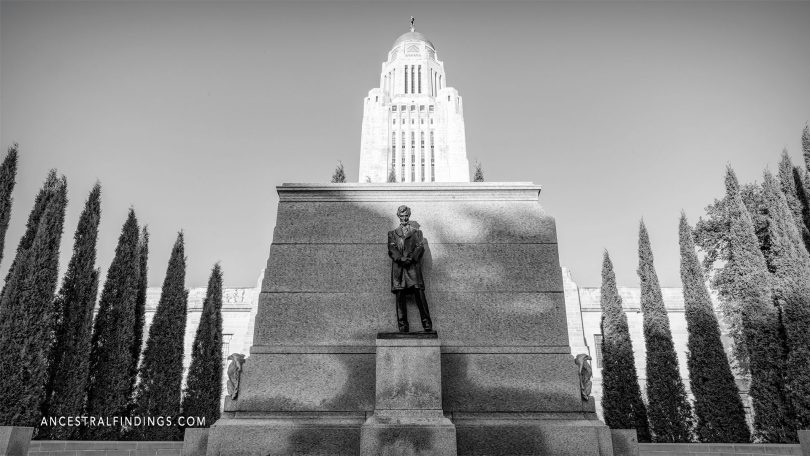Lincoln is the capital of the state of Nebraska. It is also the county seat of Lancaster County. It has a population of about 290,000 people. Lincoln is the second most populous city in Nebraska, after Omaha. It is also the seventieth most populous state in the nation. It is the anchor of the Lincoln Metropolitan area, as well as of the Lincoln-Beatrice Combined Statistical area.
Lincoln was founded in 1856. Initially, it was called Lancaster and was located on some barely inhabitable salt marshes. After the Civil War, it was renamed after US President Abraham Lincoln, and it was made the state capital in 1869. The state capitol building was designed by Bertram Goodhue, and building on it was completed in 1932. This building is the second tallest state capitol building in the country. The state of Nebraska and the US Federal Government are major employers in the city.
The University of Nebraska was founded there the same year Lincoln was made the state capital. It is now the largest university in Lincoln and the third largest employer in the city. It has approximately 26,000 students enrolled at it.
Lincoln was designated as a refugee-friendly city in the 1970s by the US Department of State, and was the twelfth largest resettlement site in the nation in 2000. Refugees from Vietnam, Burma, Sudan, and Iraq have all settled there, as well as from other people from the Middle East. Lincoln Public Schools enrolled 3,000 students from 150 different countries during the 2018-2019 academic year. Among those international students were speakers of 125 different languages.
Before European settlers came there, this prairie and swamp area was deep with buffalo grass. The Plains Indians, a Native American tribe who were descended from the unnamed people who lived there for thousands of years prior, were there when the Europeans came. Among the Plains, people were the Pawnee (which consisted of four different tribes), the Lakota, and the Great Sioux Nation. All of these tribes used the area that is now Lincoln as a hunting and skirmishing ground. While European settlers killed off or drove away most of the buffalo early on, the occasional one could still be spotted in the Lincoln area into the 1860s.
The first European settlers in Lincoln were drawn there by the abundance of salt in the salt marshes. After J. Sterling Morton developed salt mines in Kansas, many people moved west to find new sources of it that could bring them wealth. Captain W.T. Donovan and his family moved to Salt Creek, near present-day Lincoln, in 1856. Three years later, other villagers who had followed the Donovan family there met to put a caucus together to select the principal seat of the Nebraska territory. They selected Lancaster, which is now Lincoln, and also made it the county seat of the new Lancaster County. The city was first platted in 1864.
About four years after the platting, the city had a population of around five hundred people. The renamed city of Lincoln was incorporated in 1869.
More settlers came to Lincoln after the Homestead Act of 1862. In 1867, Nebraska was granted statehood. Omaha had been the capital of the Nebraska Territory since its creation in 1854. Most of the population of Nebraska lived south of the Platte River at the time statehood was granted. Most of the people living south of the Platte River were considering becoming part of Kansas, so to prevent this, the legislature of the territory voted to move the capital from Omaha to a more convenient location. This would have put the capital much farther to the west.
Omaha-based state senator J.N.H. Patrick tried to stop the move by offering to name the future state capital after the recently assassinated and beloved US President Abraham Lincoln. Most of the people south of the Platte River were Confederate sympathizers. Senator Patrick assumed that the senators located south of the Platte would not vote to move the capital if it was going to be named after President Lincoln. After all the finagling, the offer to rename the capital did not sway the voters. A vote to move the territorial capital to the south of the Platte River was successful with the Removal Act of 1867.
This act mandated the formation of a Capital Commission to choose a site for the capital on state-owned land. The Commission, which included three politicians from Nebraska, toured different sites beginning in 1867. The town of Lancaster was selected because it was near the salt flats and marshes. Lancaster had about thirty residents at the time. It also had a plat. The original plat was disregarded, and Lancaster was re-platted as Lincoln. It was also re-platted on a much larger scale. The original plat of Lancaster was kept only in that the new platting for Lincoln was laid over it. Lancaster, therefore, was incorporated into Lincoln.
Once the location was settled upon, the name changed, and the town re-platted, an auction of city lots in Lincoln was held to raise money to build the city. The auction winners and other new residents began arriving, and Lincoln became a much larger city than Lancaster had been. The first capitol building was completed in 1868. It was a two-story building made with limestone from the area and included a central cupola.
A new capitol building was built on the site of the original one in 1888. This new building was commissioned because the first one was structurally unsound. This old and uninspiring building was discarded, and a third capitol building was made by Bertram Goodhue, with construction beginning in 1922. The building was completed in 1932 (and the old, second capitol building was razed in 1925). The Goodhue design was tinkered with over the years, and his original vision for the building was finally completed with the addition of the capitol fountains within the four interior courtyards of the capitol building in 2017.







